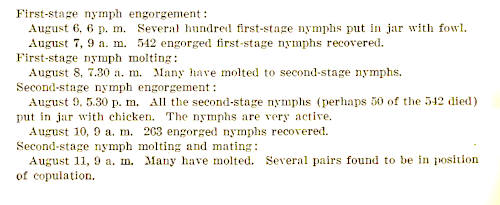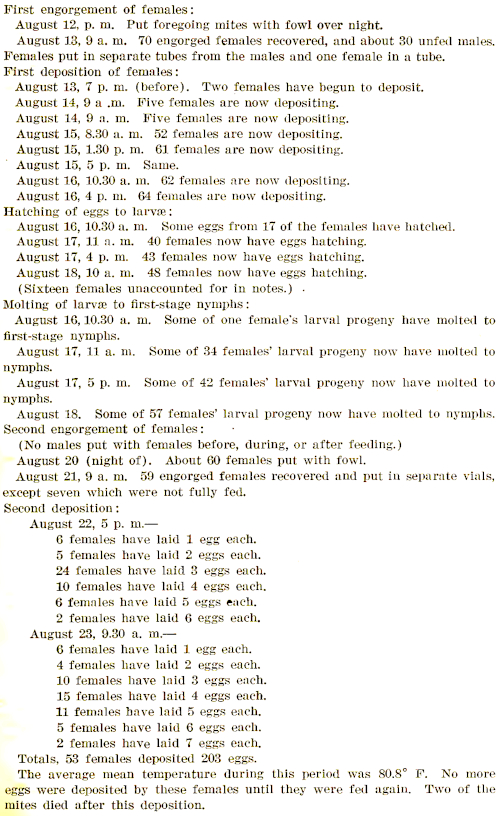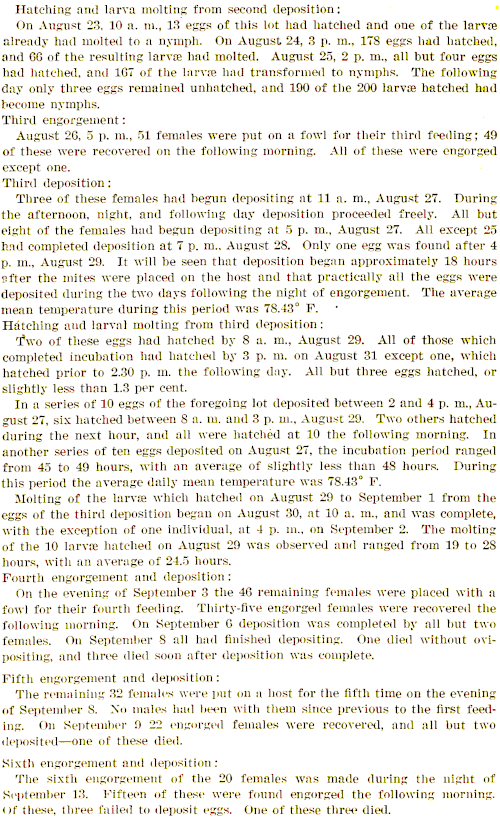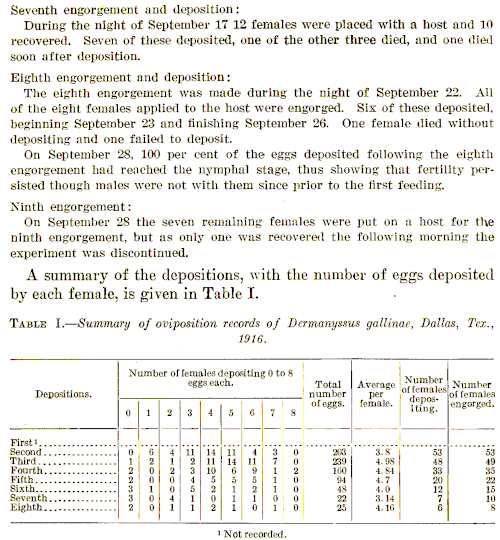Chicken mites, what are they and how to deal with them. With mite FAQ'S.
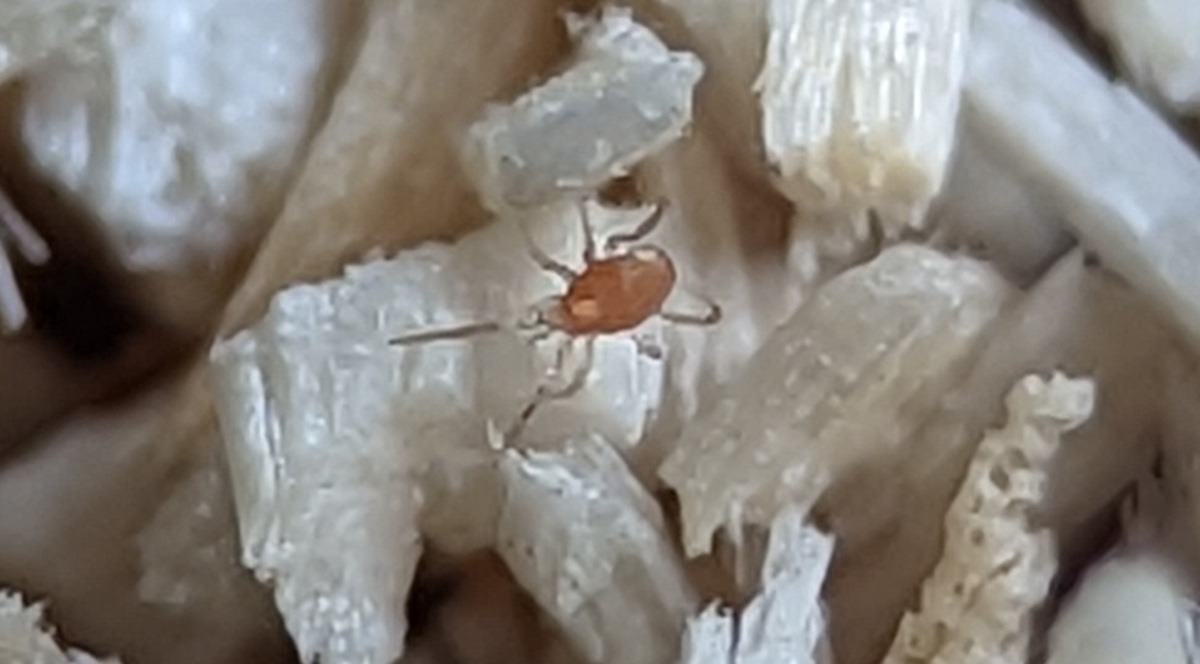
All chicken mites are the source of much frustration to chicken keepers the world over and are very difficult to get rid of.
Table of Contents
- What do chicken mites look like?
- How common are chicken mites?
- How many species of chicken mites are there and what are their scientific names?
- What is the difference between chicken lice and chicken mites?
- What are the signs of mites in chickens?
- How long do chicken mites live?
- What do mites do to chickens?
- How do chickens catch mites?
- How do you get rid of mites on chickens?
- What eats chicken mites?
- What will kill chicken mites?
- Can chicken mites live on humans and infest your house?
- Do chicken mites jump?
- Can you eat a chicken with mites?
- What is the life cycle of a chicken mite?
- The images and results tables and pages from the chicken mite life cycle experiment:
What do chicken mites look like?
Chicken mites are small ectoparasites which live on the outside of the host, have 4 pairs of legs, biting mouth parts and are part of the spider or arachnid family of creatures.
You can just see chicken mites with the naked eye.
Below: A red mite with a coin to show size.
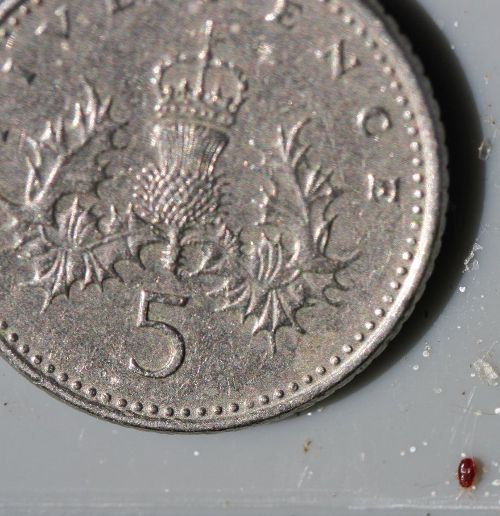
Chicken mites are an average of 538 microns or 0.54 mm long and 300 microns or 0.3 mm wide before feeding and are light Grey in colour.
Below: Here is a video of red mites moving around.
Mites look different depending on whether they have recently fed or not.
Below: A female chicken mite before feeding looks like this.
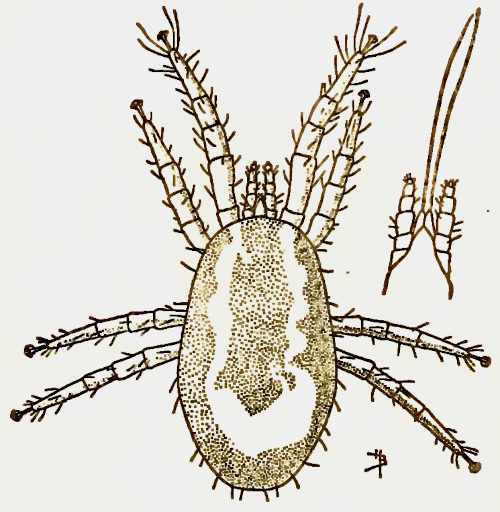
After feeding chicken mites are nearly half as big again and measure an average of 752 microns or 0.75 mm in length and 462 microns or 0.46 mm wide and turn a bright red colour.
Below: A female chicken mite after feeding.
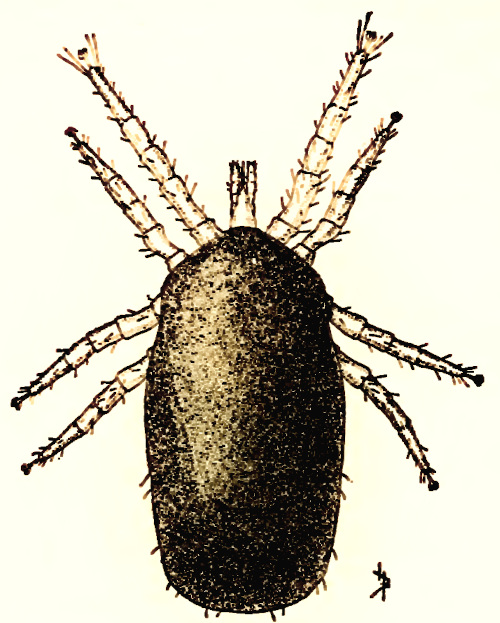
The chicken mite egg is small, oval, smooth, pearly white and has an iridescent look. Eggs are 300 microns or 0.3 mm long and 200 microns or 0.2 mm wide.
Below: Chicken mite eggs look like this.
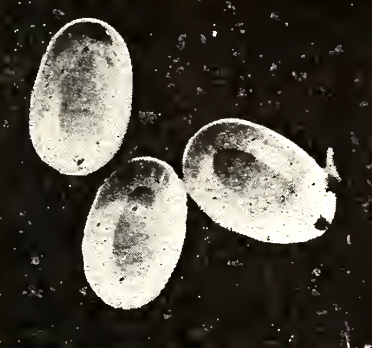
Mite eggs take from 48 to 72 hours to hatch depending on the temperature of the environment.
How common are chicken mites?
Chicken mites are found in every country and territory around the world and are a threat to meat and egg production.
Mites and egg are resilient and adults can survive for months without feeding and therefore spread easily.
Reservoirs of mites survive in wild birds and can also infest turkeys, guinea fowl and pigeons.
Chicken mites reproduce incredibly fast, the average rate of egg laying is 4 per day and one female mite could produce 2609 offspring in an eight week life.
How many species of chicken mites are there and what are their scientific names?
The most economically important and widespread chicken mite is the red mite.
List of common chicken mites:
- Red Mite - scientific name: Dermanyssus gallinae.
- Northern Fowl Mite - scientific name: Ornithonyssus sylvarum.
- Depluming mite - scientific name: Cnemidocoptes gallinae.
- Scaly leg mite - scientific name: Knemidocoptes Mutans.
- Tropical fowl mite - scientific name: Ornithonyssus bursa.
Some species of chicken mite live on the bird while some live in dark cracks and only come out to feed at night when the chickens are roosting.
What is the difference between chicken lice and chicken mites?
There are many differences between lice and mites. Not all are simple and clear cut however. Both lice and mites move by crawling and can not jump.
| Mites. | Lice. |
| Mites are 8 legged arachnids. | Lice are insects with 6 legs. |
| Mites are very small, less than 1 mm long. | Lice are often bigger being 2 to 3 mm long. |
| Mites are slow moving. | Lice are fast moving. |
| Mites are light Gray when unfed and dark red when fed. | Lice are yellow to light brown in colour. |
| Mites feed on blood. | Lice feed on skin scales and dander. |
| Do not always live on the host. Can survive for long periods without the host. | Always live on the host. Entire life cycle takes place on the host. |
| Lay larger eggs singly at a rate of 4 eggs per day. | Lay 50 to 300 eggs at a time. |
| General body wide ectoparasite. | Lice tend to be body area specific like the base of the quill of the feather. |
| Best seen and identified at night. | Best seen and identified during the day. |
Mites and lice also have different life cycles.
What are the signs of mites in chickens?
If you suspect mite infestations the best time to inspect the coop is and hour or two after the hens have roosted. Look along the perches and in the nest boxes.
Symptoms of a chicken mite infestation:
- Scratching or distracted hens.
- Over consumption of water.
- Feather loss.
- Rash, pustules or scabs. Especially on the underside or near the vent.
- Pale comb and wattles.
- Tiredness.
- Lack of appetite.
- Reluctance to enter the coop to lay eggs or roost in the evening.
- Fewer eggs.
- Hens laying eggs in unusual places.
- Blood spots on eggs indicate infestation within the cloaca of an affected hen.
Below: Mite alert is a small device for monitoring mite infestations.

How long do chicken mites live?
Results of experimentation by H.P. Wood published in 1917 found that chicken mites live for a maximum of 139 days under ideal conditions.
He also found that mites died faster in the heat of summer and in the absence of food and water.
Below: An extract from the notes on mite longevity.

Mites can survive for more than 60 days without food and Mr Wood noted that:
" The longest that adults which had never fed as adults lived was from 88 to 96 days; this was during the months of October, November, December, and January."
He also noted that the mites withstood a minimum continuous temperature of 15 Fahrenheit ( -10 Celsius) and a maximum of 97.5 Fahrenheit ( 37 Celsius) without injury.
The chicken mites with the shortest lifespan were those deprived of food and water but these still survived for 56 or more in the testing. The time of year had some impact on the longevity of chicken mites.
List of favourable condition for chicken mites:
- Frequent easy access to chickens.
- Numerous hiding places such as cracks and gaps in wood.
- Allowing dirty bedding to collect.
- Darkness is required for mites to feed.
- Damp conditions help mites live longer.
What do mites do to chickens?
Mites suck the blood of chickens. It takes approximately 1 hour for a mite to have a full feed from a chicken.
Mite bites are painful and will cause skin irritation and stress to the chickens.
Mites cause anaemia through excessive blood loss.
Chickens can die from mites literally drinking all their blood. Medically this process is called exsanguination.
Mites can pass disease to chickens.
Chickens that have been fed on by mites will lay fewer eggs and be more susceptible to other illnesses and infections.
How do chickens catch mites?
You only need one viable mite to land on your site and you can end up with an infestation.
One chicken mite can lay dozens of eggs every week or so under the right conditions.
- Straw can carry mites. You can bring it onto your site with you without knowing.
- Wild birds or animals. Probably the most common way mites move around.
- Recent flock additions. Not quarantining new birds is another way mites can get onto your chickens.
- You or your pets. You could bring one from a fellow keepers coop or you dog can carry a few in.
How do you get rid of mites on chickens?
None of the species of chicken mites go away on their own without ongoing treatment.
The best and fastest way to get rid of mites on chickens is with a chemical or prescription treatment from a veterinarian.
List of approved treatments for chickens mites:
- Predator Mites. An effective and chemical free method of killing mites.
- Dergall. A concentrated liquid that is diluted and sprayed in the hen house.
- Exzolt . You will need a prescription from your vet in order to purchase Exzolt.
- Ivermectin. An anti parasitic drug.
Treatments need to be repeated every 7 to 14 days to interrupt the life cycle of the mites.
Changing and burning the bedding and nesting material every few days will help as will cleaning more often and filling in cracks and gaps in the coop construction.
What eats chicken mites?
A small black ant (Monomorium minimum) has been seen to carry away recently fed mites. Other species, notably the fire ant (Solenopsis geminata) destroy many. Certain spiders also have been seen to attack and destroy mites.
Predator mites are available as a method of biological control.
What will kill chicken mites?
This has been well studied over the years as chicken mites are expensive to the poultry industry.
Prolonged sun exposure will kill mites effectively.
Chemical treatments and prescription drugs like Exzolt will kill chicken mites.
Prolonged heat and cold will kill chicken mites. Sustained temperatures below 0 Fahrenheit (-18 Celsius) and above 140 Fahrenheit (60 Celsius). Boiling water from a kettle will kill mites on contact.
Prolonged contact with Diatomaceous earth will kill mites over time. It takes around 3 to 5 days to begin to be effective and need to be reapplied every week for the whole life cycle of the mite.
Vinegar, bleach and most other home remedies will not kill mites in any significant quantity.
W. M. Davidson experimented with many substances in the 1920's trying to find an effective mite killer. He found the only real way of controlling mites was coal tar or wood tar oil, similar to pitch.
He also found very high concentrations of permethrin to be effective.
Below: Recommendation for mite control from research.

Unfortunately these have mostly been removed from sale around the world as they are carcinogenic.
Can chicken mites live on humans and infest your house?
Chicken mites will not live on humans but will bite if disturbed and feed on human blood if chickens are not available.
Chicken mites are not normally harmful to humans but some people may react badly to the bites. Symptoms of mite bites in humans include a rash, redness and swelling, irritation and itching.
Below: The author noting how it felt to have mites on his skin.
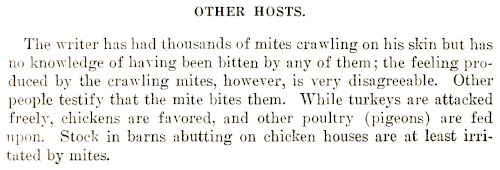
Some people may not notice mite bites at all.
During his experiments Mr Wood noted:
"The writer has had thousands of mites crawling on his skin but has no knowledge of having been bitten by any of them. The feeling produced by the crawling mites, however, is very disagreeable. Other people testify that the mite bites them. While turkeys are attacked freely, chickens are favoured, and other poultry (pigeons) are fed upon. Stock in barns abutting on chicken houses are at least irritated by mites."
Your family pet cat, dog and rabbit could easily be irritated by chicken mites but they will not become infested.
Do chicken mites jump?
Mites can not jump and have to crawl to get where they are going.
Mites are attracted to warmth and carbon dioxide.
Can you eat a chicken with mites?
Eating sick or infested birds is not a good idea and can make you sick. That said I do know people who have eaten birds with lice and mites and suffered no ill effects.
Mites carry disease and will likely effect the quality of the meat on the carcass.
You could also find the skin of the chicken is contaminated with mites as you are processing it.
On that note you may also get bitten by the mites when you are dealing with and plucking your bird.
What is the life cycle of a chicken mite?
Chickens mites have 5 stages in the life cycle.
Below is a table with the amount of time the mites spends in each stage.
| Life cycle stage of mite. | Amount of time spent in that stage. |
| The egg stage. | 48 to 72 hours. |
| The larva or larval stage. | 24 to 48 hours. |
| First stage nymph. | 24 to 48 hours. |
| Second stage nymph. | 24 to 48 hours |
| Adult. | up to 140 days. |
Time spent in each life cycle stage depends on temperature, food and environment.
The egg stage:
The chicken mite egg is small, oval, smooth, pearly white and has an iridescent look. eggs are 300 microns or 0.3 mm long and 200 microns or 0.2 mm wide
Below: Mite eggs.

Mite eggs take from 48 to 72 hours to hatch depending on the temperature of the environment.
The larval stage:
The young larva on hatching is white and has only three pairs of legs and the rear of the abdomen has a small protuberance which does not appear on any other stage.
Below: The larval stage.
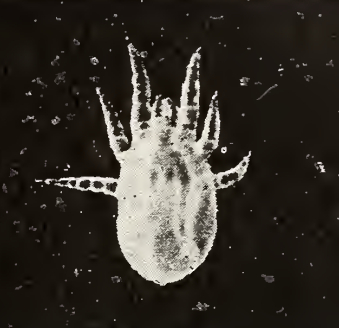
The larva moves about slowly, unlike the other stages, which are very active. The length and width of the larval body measure practically the same as those of the egg.
Without ever having fed, the larva moult to nymphs. Moulting takes place in about 24 hours after hatching.
The first stage nymph:
The young nymph backs out of its larval skin like a person drawing his hand out of a tight glove.
Below: The nymph.
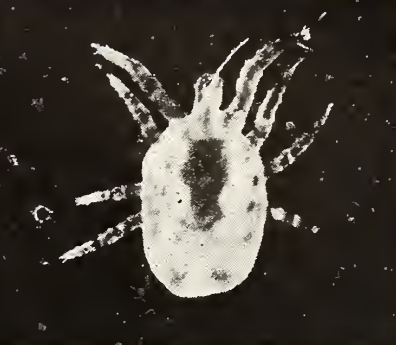
It has now acquired another pair of legs, making four pairs. After a few hours of resting, to give time for the body integument to harden, it becomes very
active and will now feed if given a chance.
Below: Experimental data showing life cycle phases and timings.

The first stage nymph is slightly darker in colour than the larva and has long piercing mouth parts to suck the blood of the fowl.
The second stage nymph:
The second-stage nymph, like the preceding stage, requires a short period of rest to harden the integument after which it becomes active and looks to feed.
The adult stage:
The second stage nymphs moult into the adult stage. Adult stage mites rest a short time and then look to feed and reproduce.
Chicken mites are capable of going from egg to adult inside 10 days.
Below: An adult chicken mite.
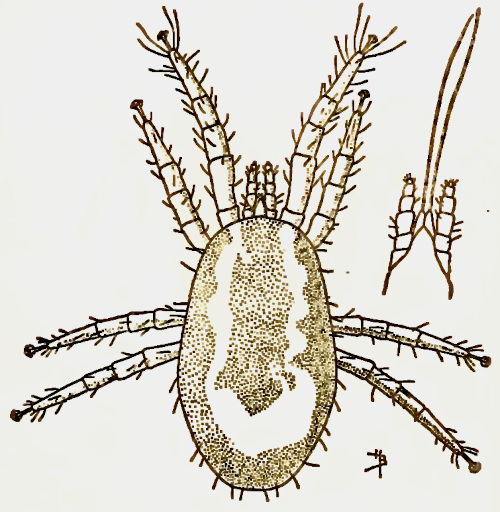
Male mites rarely feed and spend most of their time looking for or clasping a female and a female mite can remain fertile for weeks after mating.
Females begin to deposit eggs with 12 hours of feeding and will continue to lay every 6.4 hours or so while ideal condition permit.
The images and results tables and pages from the chicken mite life cycle experiment:
Below: observation from chicken mite life cycle experiment.
